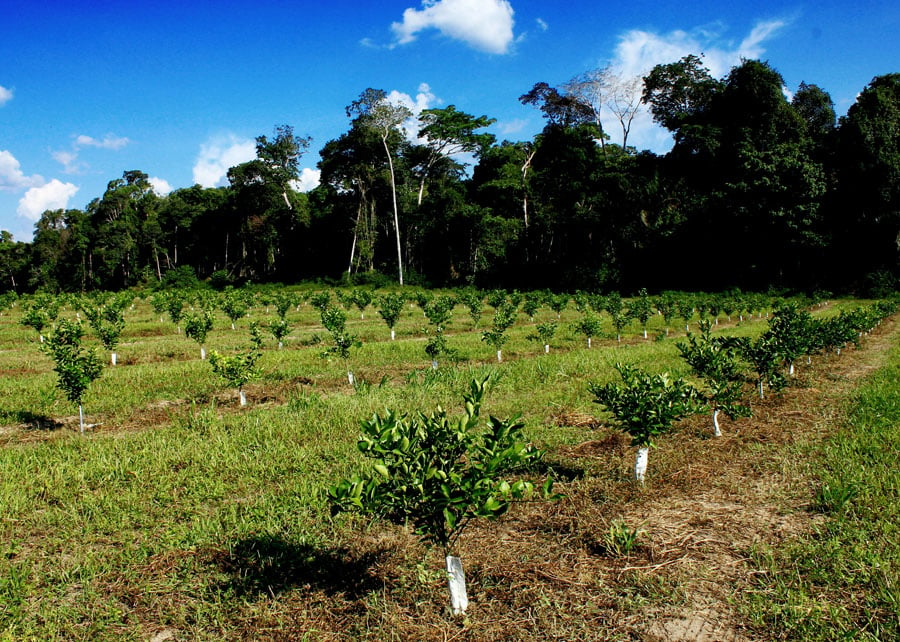Project will map carbon stocks and wildlife in Brazilian citrus belt
Embrapa and Fund for Citrus Protection (Fundecitrus) are initiating this month a joint scientific investigation to quantify carbon stocks and identify wildlife in the “citrus belt”, shared by the states of São Paulo and Minas Gerais, the largest worldwide. The project has funded by Innocent Drinks, via Farmer Innovation Fund, to offer funding to projects […]

Embrapa and Fund for Citrus Protection (Fundecitrus) are initiating this month a joint scientific investigation to quantify carbon stocks and identify wildlife in the “citrus belt”, shared by the states of São Paulo and Minas Gerais, the largest worldwide.
The project has funded by Innocent Drinks, via Farmer Innovation Fund, to offer funding to projects that aim to reduce carbon emissions in agriculture and inspire other farmers to adopt best practices.
The work will gather carbon stocks data about both orange orchards and native vegetation areas within the farms, a territory of nearly 600,000 hectares. The researchers will use different methods to do that.
The first one involves weighing trees, by sampling, to calculate the average amount of carbon stored in each one of them and, after, per hectare and for the whole citrus belt.
Data from the Tree Inventory produced by Fundecitrus in 2021 show that production areas alone (without native vegetation inside farms) cover more than 400,000 hectares in São Paulo and Minas Gerais citrus belt.
“We will find out how much carbon is sequestered by orange trees in the citrus belt and how much carbon is fixed by native trees at the preservation areas within orange farms”, adds Fundecitrus’ Orange Production Forecast coordinator, Vinícius Trombin.
Mapping, estimation, pricing
The data will be combined with information about types of vegetation in Brazil, produced by the Brazilian Institute of Geography and Statistics (IBGE). After that, researchers will calculate the amounts of carbon stocked in vegetation areas.
“We will combine information on land use and cover, maps of vegetation types made available by IBGE and secondary data on carbon stocked in different types of vegetation, both in the Atlantic Rainforest and Cerrado”, sums up Lauro Nogueira, Embrapa´s researcher and project leader.
Researchers will estimate the monetary value of carbon in the areas dedicated for preservation. The goal is that this indicator can be used as a parameter for programs of payment for environmental or ecosystem services.
“This may lead to payment for this environmental service, which the orange farm provides, or to conversion to currency in negotiations for better prices in the international market”, analyzes Nogueira.
Wildlife
Aside from carbon stocks, Embrapa and Fundecitrus will investigate how orange farms may be habitats for wildlife. “Biodiversity is an indicator of environmental quality”, says Embrapa’s researcher José Roberto Miranda. He will coordinate an effort to identify vertebrates, especially birds and mammals, living in orange farms.
Footprints, nests, burrows, hairs, feathers and feces. These will be the main traces sought by the researchers. Miranda says that in some situations, studying the footprints or feces will be enough to identify the animal that left them.
“Animals will be detected and identified mainly through direct observation in field surveys. The use of binoculars helps to see details and identify the species at a distance”, adds Miranda.
World´s largest producing
The citrus belt ranging from the Southwest/Triangle of Minas Gerais to São Paulo is the main producer of juice oranges in the planet. According to Markestrat data, the industry moves nearly US$ 14 billion per year, which add R$ 2 billion to the Brazilian gross domestic product (GDP), from exports alone.
It is responsible for 35% of the world’s orange production and 75% of the international orange juice market – six out of ten glasses of the beverage consumed in the world come from the Brazilian citrus belt.
Over the last 30 years, due to improved efficiency in the control of pests and diseases, in crop treatments, and in use of technology and densification, the region’s average productivity more than doubled – from 330 boxes per hectare in 1988/1989 to 830 boxes on average over the latest six harvests. Planted areas, on their turn, decreased 40%.
A survey performed by Fundecitrus based on a method developed by Embrapa also quantified the territory assigned for permanent preservation areas and legal reserves.
For every 2.52 hectares of citrus crops in São Paulo and Southwest/Triangle of Minas Gerais, there is 1 hectare dedicated for the preservation of native vegetation, amounting to over 180,000 hectares. These numbers are based on a complete mapping of the citrus belt, produced by Fundecitrus in 2017, and on data from the Brazilian Rural Environmental Registry (CAR).

